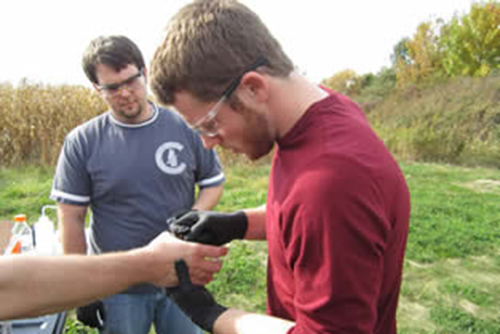Christopher Mulligan, associate professor of analytical chemistry, is making strides toward developing cutting-edge instrumentation for chemical detection in his lab at Illinois State University. The application of his work is broad, ranging from detecting contamination in water—such as pharmaceuticals and pesticides—to improving crime scene forensics.
Mulligan explained, “As more and more new medicines and chemicals become available for public use, the more difficult it becomes to detect these potential contaminants in water sources and aquatic environments.”
One of his discoveries, coined as thermally-assisted desorption electrospray ionization, resulted from a grant-funded project five years in the making that will test water samples much more quickly than the current technology available. “Traditional testing methods for water contaminants involve transporting three or more liters of water, per test, to an off-site lab for analysis,” said Mulligan. “This becomes expensive to ship the samples themselves, and the time involved for the testing could take hours, if not days. Our method can take as little as one minute and 1 milliliter of water.”
The new way of testing water will not only be quicker and cheaper, it will allow more experiments to be done, per unit of water, and will ultimately allow testing at the site of the contamination. “In a couple of years, we will eventually be able to go on location,” said Mulligan. He pointed out that he looks forward to seeing the fruit of his labor when the technology is out there being used.
Mulligan has two patents regarding this work and is in the process of working with Illinois State University Patent Officer Cory Abernathy for licensing. ”Hopefully someone will be interested in commercializing these prototypes, and Cory will help with this,” said Mulligan. “It’s great to be able to talk to someone who is well versed in this and can tell me what I need to do. Cory is a great addition to the University.”
Crime scene investigation and forensics is another passion of Mulligan’s. He and his student-based research team have been working on cutting-edge tools for use in crime scene investigations through funding from the National Institute of Justice (NIJ). Specifically, they are developing portable mass spectrometers that allow chemical identification of evidence found in any state—solid, liquid, gas, or solution.

Student Adam O’Leary utilizes the portable mass spectrometer to test unknown white powders provided by the Iowa State Police.
“This new technology would allow evidence screening to occur rapidly right at a crime scene rather than be shipped off for analysis at off-site forensics labs, expediting criminal investigations and assessing potential public safety concerns,” explained Mulligan. “TV shows like CSI are notorious for using a bit of movie magic when it comes to depicting the technologies available to forensic investigators. We are working hard to actually make these futuristic tools for the people who are tasked with keeping us safe.”
This could also be beneficial in homeland security and environmental monitoring applications. “Our instrumentation is well suited to fulfill the needs of first responders and homeland security personnel. We have done studies on chemical warfare agent simulants and other threats to demonstrate this ability. Also, explosives and related compounds could be measured. The portable nature of our instrumentation would have high utility in this area,” explained Mulligan.
Mulligan and his team have examined authentic forensic evidence in the past, both in a proof of principle way to see if their instrument could actually work towards an application and also as part of on-going investigations. “We have worked with the Iowa State Police to look at seized white powders (cocaine and methamphetamine), and we were able to test our instrumentation in a mock clandestine methamphetamine lab under DEA (Drug Enforcement Administration) supervision,” he said. “Other interesting forensic studies can be done, as well. For example, we can test a fingerprint and know immediately what the suspect has touched—a few examples of chemicals found might be illegal drugs, nicotine from a cigarette or a certain cologne,” he said.
To date, Mulligan’s group is the only academic laboratory that utilizes and maintains this specific instrumentation. Recently, his research program was included in the “success stories” from the National Institute of Justice (NIJ) grantee projects that the NIJ acting director utilizes when briefing nonscientists. Mulligan is in the process of exploring other potential patents in forensic chemical analysis.

